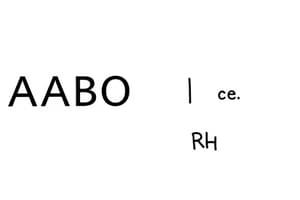Podcast
Questions and Answers
Which of the following is the MOST accurate description of immunohematology?
Which of the following is the MOST accurate description of immunohematology?
- The study of blood group antigens and antibodies, along with their role in transfusion reactions and hemolytic disease. (correct)
- The study of the immune system's role in hematological malignancies.
- The study of blood coagulation disorders and their treatments.
- The study of the morphology of blood cells under various pathological conditions.
HLA antigens are exclusively found on red blood cells and play no role in tissue transplantation compatibility.
HLA antigens are exclusively found on red blood cells and play no role in tissue transplantation compatibility.
False (B)
What is the primary difference between alloantibodies and autoantibodies in the context of blood transfusions?
What is the primary difference between alloantibodies and autoantibodies in the context of blood transfusions?
Alloantibodies are formed against antigens from individuals of the same species, whereas autoantibodies are made in response to the body's own antigens.
The heavy chain of an antibody molecule is primarily responsible for determining the ______ of the immunoglobulin.
The heavy chain of an antibody molecule is primarily responsible for determining the ______ of the immunoglobulin.
Match each immunoglobulin class with its key characteristic.
Match each immunoglobulin class with its key characteristic.
In the context of antigen-antibody reactions in blood transfusions, what does sensitization refer to?
In the context of antigen-antibody reactions in blood transfusions, what does sensitization refer to?
Increasing the serum-to-cell ratio in agglutination tests will always enhance the strength of the agglutination reaction.
Increasing the serum-to-cell ratio in agglutination tests will always enhance the strength of the agglutination reaction.
What role do antibodies play in the development of hemolytic disease of the fetus and newborn (HDFN)?
What role do antibodies play in the development of hemolytic disease of the fetus and newborn (HDFN)?
In vitro antigen-antibody reactions in immunohematology are optimally performed at a pH of ______.
In vitro antigen-antibody reactions in immunohematology are optimally performed at a pH of ______.
Which of the following historical events marked the beginning of blood transfusions, although initially performed between animals?
Which of the following historical events marked the beginning of blood transfusions, although initially performed between animals?
All blood group antigens are proteins.
All blood group antigens are proteins.
Explain why incompatible HLA antigens can cause fever and chills.
Explain why incompatible HLA antigens can cause fever and chills.
The phenomenon where an excessive antibody concentration inhibits agglutination is known as ______.
The phenomenon where an excessive antibody concentration inhibits agglutination is known as ______.
Which of the following factors primarily affects the second stage (visual agglutination) of an antigen-antibody reaction?
Which of the following factors primarily affects the second stage (visual agglutination) of an antigen-antibody reaction?
IgA antibodies can efficiently fix complement.
IgA antibodies can efficiently fix complement.
Why is pretransfusion testing essential in immunohematology?
Why is pretransfusion testing essential in immunohematology?
Antibodies produced in response to antigens from another species are called ______.
Antibodies produced in response to antigens from another species are called ______.
Which scientist is credited with discovering the first three human blood groups (A, B, and O)?
Which scientist is credited with discovering the first three human blood groups (A, B, and O)?
More than 600 blood group antigens have been described, but most are clinically significant.
More than 600 blood group antigens have been described, but most are clinically significant.
Describe the role of B lymphocytes in producing immunoglobulins.
Describe the role of B lymphocytes in producing immunoglobulins.
The optimal temperature for most clinically significant antibodies to react is ______.
The optimal temperature for most clinically significant antibodies to react is ______.
Which of the following characteristics distinguishes IgG antibodies from IgM antibodies in the context of transfusion reactions?
Which of the following characteristics distinguishes IgG antibodies from IgM antibodies in the context of transfusion reactions?
IgA antibodies can cause agglutination in saline.
IgA antibodies can cause agglutination in saline.
Explain how incubation time affects the first stage of agglutination
Explain how incubation time affects the first stage of agglutination
An increase in the amount of ______ will subsequently increase the number of antibodies in the solution.
An increase in the amount of ______ will subsequently increase the number of antibodies in the solution.
Flashcards
Immunohematology Definition
Immunohematology Definition
The study of blood group antigens and antibodies, pretransfusion testing, and immune hemolysis.
Antigen (Ag)
Antigen (Ag)
Substances recognized as foreign by the body that can trigger an immune response.
Antibody (Ab)
Antibody (Ab)
Immunoglobulins developed in response to antigens.
Human Leukocyte Antigens (HLAs)
Human Leukocyte Antigens (HLAs)
Signup and view all the flashcards
Heteroantibodies
Heteroantibodies
Signup and view all the flashcards
Alloantibodies
Alloantibodies
Signup and view all the flashcards
Autoantibodies
Autoantibodies
Signup and view all the flashcards
Antibody Heavy Chain
Antibody Heavy Chain
Signup and view all the flashcards
Immunoglobulins
Immunoglobulins
Signup and view all the flashcards
Antibodies against RBC antigens
Antibodies against RBC antigens
Signup and view all the flashcards
IgM Antibody
IgM Antibody
Signup and view all the flashcards
IgG Antibody
IgG Antibody
Signup and view all the flashcards
Hemagglutination
Hemagglutination
Signup and view all the flashcards
Optimal pH
Optimal pH
Signup and view all the flashcards
Study Notes
- Course Title: Transfusion Science 1 Theory
- Credits allocated for theory: 2
- Pre-requisite course: Introduction to Immunology
- Co-requisite course: Transfusion Science Practical
- Tutor: Dr. Alfatih Aboalbasher Yousif
Course Objectives
- Discuss ABO alleles at the molecular level
- Apply ABO/Rh allele frequency and genotyping estimation
- Explain the ABO blood group system
- Interpret different ABO discrepancy cases
- Explain the Rh blood group system and D weak phenotype
- Explain the principles of direct tests and indirect AHG tests
- Describe the significance of other blood group systems
- Describe antibody screening and identification
- Explain donor room procedures, including blood collection, donor care, processing, storage, and blood products
- Describe the quality control program in blood transfusion practice
Evaluation Scheme
- Mid Semester: 30%, 1 hour 30 min., Week 6
- Quiz: 10%, 30 min., Week 12
- End of Semester exam: 60%, 2 hours, Week 16/17
Immunohematology Overview
- It studies blood group antigens and antibodies
- It studies HLA antigens and antibodies.
- It involves pretransfusion testing
- It involves identification of unexpected alloantibodies
- It involves immune hemolysis, autoantibodies and drugs
- It includes Safety, Quality Assessment & Blood Inventory Management
History of Blood Transfusion
- 1665: First blood transfusions (dog-to-dog)
- 1667: Successful transfusions (animal-to-human)
- 1818: First successful transfusion (human-to-human)
- 1901: Discovery of human blood groups A, B, and O
- 2017: Development of method to produce blood unit from stem cells
Antigen Characteristics
- Antigens are substances recognized as foreign by the body
- They react with products of a specific immune response.
- Blood group antigens exist on the surface of red blood cells (RBCs).
- Over 600 antigens have been described with only a few clinically significant
Antibodies Characteristics
- Antibodies (Ab): Immunoglobulins (Ig) developed in response to the presence of antigens
- Immunogens are made of proteins, carbohydrates, or combinations
Human Leukocyte Antigens (HLAs)
- HLAs appear on leukocytes and tissue cells
- Incompatible HLAs may cause fever and chills
- HLA test applications include organ, tissue, BM, and stem cell transplantation.
- Platelet antigens are found on membranes.
- Platelet antibodies occur less frequently.
Types of Antibodies
-
Heteroantibodies (Xenoantibodies): Antibodies produced in response to antigens from another species
-
Alloantibodies: Formed in response to antigens from individuals of the same species
- They are a type of antibodies involved in transfusion reactions
-
Autoantibodies are made in response to the body's own antigens
-
The heavy chain is responsible for the immunoglobulin group specificity
Antibodie Classes
- Immunoglobulins are produced by B lymphocytes.
- Five classes of Immunoglobulins: IgG, IgA, IgM, IgE, and IgD
- Only IgG, IgM, and (rarely) IgA antibodies are produced against RBC antigens
- IgA antibodies produced against RBC Ag usually occur with IgG and IgM
- IgA does not cross the placenta
- IgA does not fix complement
- IgA antibodies can cause agglutination in saline
IgM
- Made of five basic Ig units (pentamer)
- They directly bind with RBCs and cause agglutination
- Can activate complement
- They cannot cross the placenta
- React optimally at RT or 4°C
- Usually clinically insignificant
IgG
- a single Immunoglobulin unit
- Cannot visibly agglutinate RBCs
- Cannot activate complement unless two molecules are present (i.e., IgG3).
- Can cross the placenta
- React optimally at 37°C
- Clinically significant, causing TR, (HDFN)
Antigen-Antibody Reactions
- Hemagglutination is the agglutination of the RBCs.
- Hemagglutination occurs in two stages:
- Sensitization
- Visible agglutination
Factors Affecting Stage 1 of Agglutination
- Serum to Cell Ratio: Increased serum amount yields an increased number of antibodies in the solution
- Reaction Temperature: Most clinically important antibodies react best at 37°c
- Incubation Time and ionic strength of the suspension medium allow sufficient time for antibody attachment
- Optimal pH for in vitro reactions is 7
Factors Affecting Visual Agglutination
- Reaction Temperature
- Incubation Time
- pH
- Repelling Negative Charges
Studying That Suits You
Use AI to generate personalized quizzes and flashcards to suit your learning preferences.



